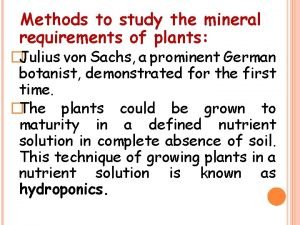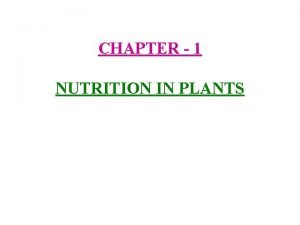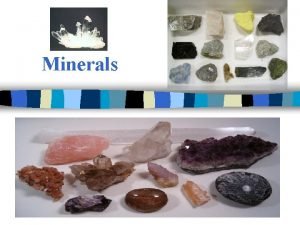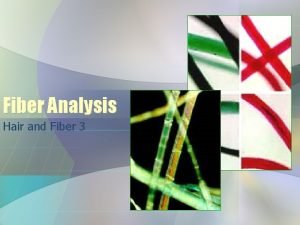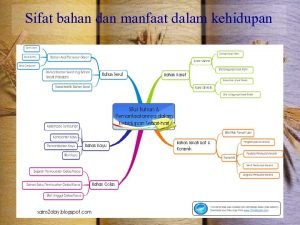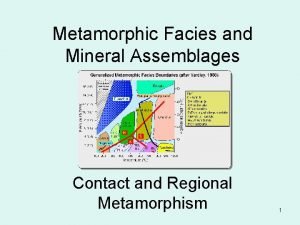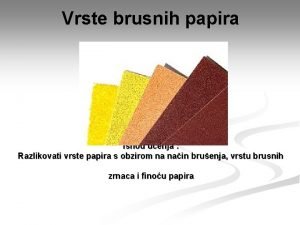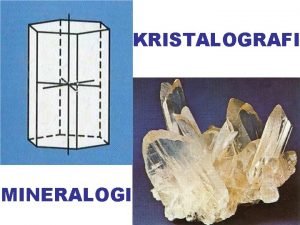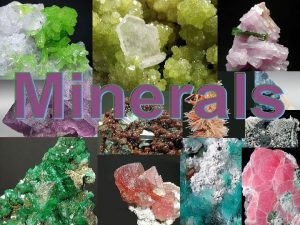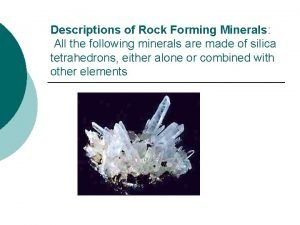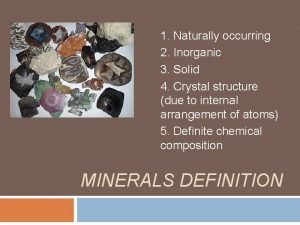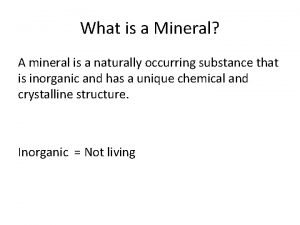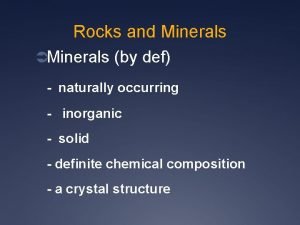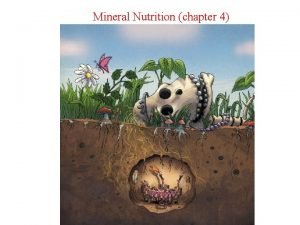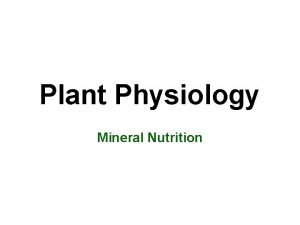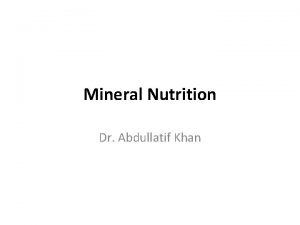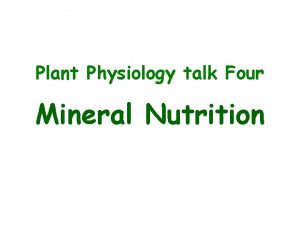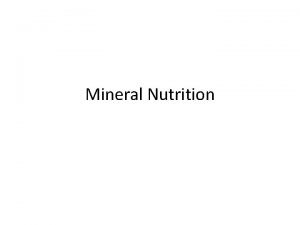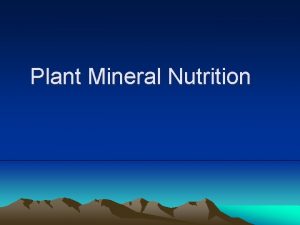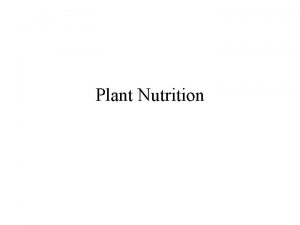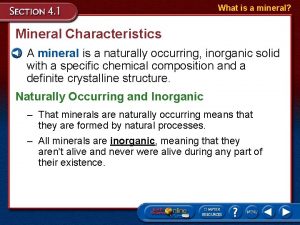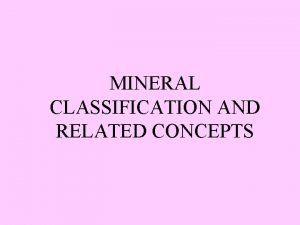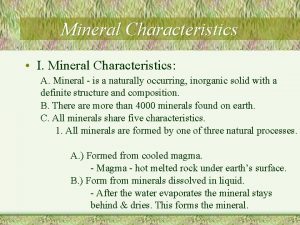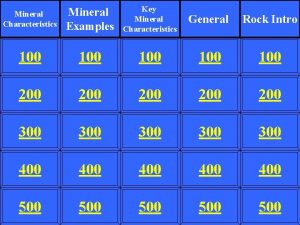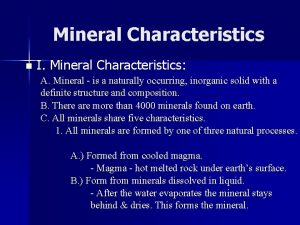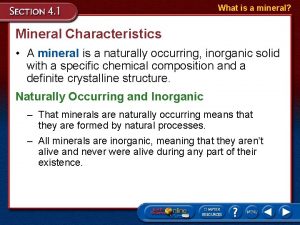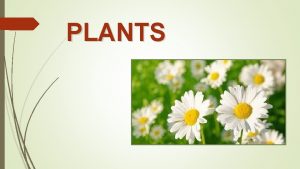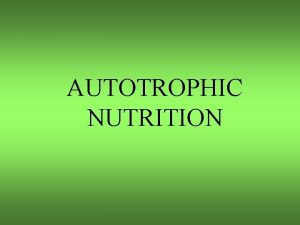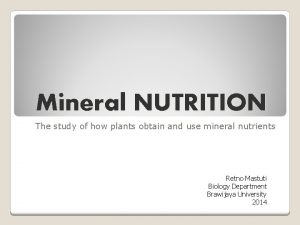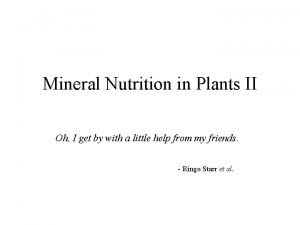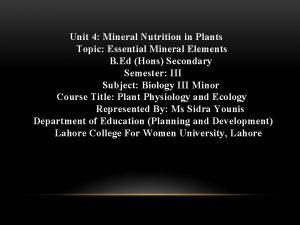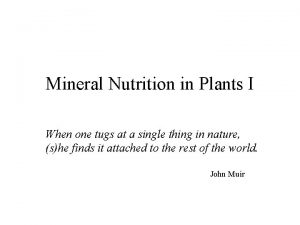Mineral Nutrition in Plants II Oh Oh I





























- Slides: 29

Mineral Nutrition in Plants II Oh Oh, I get by with a little help from my friends. - Ringo Starr et al.

Today • Nitrogen Assimilation; • Mychorhizzae; • Questions.

Structural Elements, Covalently Bonded I Group 1: Nutrients that are parts of carbon compounds. . . • N: amino acids, proteins, nucleic acids, coenzymes, etc. – – forms three covalent bonds, chains, rings, branches, one pair unshared electrons for metal coordination, carbon “substitute”; distorts symmetry in rings and chains, – participates in hydrogen bonding, – metal complexion (see chlorophyll), • Triple bond is extremely stable.

History Varro praeceptis adicit equino sit levissium segetes alendi, prata vero graviore quod ex hordeo fiaat multasque gignat herbas…inter omnes autem constat nihil esse utilis lupini segete priusquam siliquetur aratro vel bidentibus versa manipuisve desectae circa radices arborum ac vitium obrutis… - Pliny the Elder (~A. D. 80) Haber-Bosch Reaction

Nitrogen Gas N N N 2 gas Nitrogen Species Oxidation State Name …as a reactant, is of limited use to most living organisms, …some prokaryotes can break the triple bond and form ammonia, …eukaryotes do not have the enzymes required to perform this task. …plants assimilate nitrate and ammonium, – NO 3 - and NH 4+.


Free-Living Nitrogen Fixation • Cyanobacteria (blue green algae), – i. e. Anabaena, • Other bacteria, Anabaena - heterocysts: cells adapted for nitrogen fixation; Anaerobic: maintain anaerobic lifestyles, Facultative: can switch to anaerobic metabolism, Aerobic: adapt specific cells for “anaerobic” metabolism. • no O 2.

Nitrogen Fixation is Sensitive to O 2 Ammonia and H 2 Output. 8 reduced ferredoxins N 2 O 2 is a good electron acceptor. 8 protons

Sources of Fixed Nitrogen I Oxidation of ammonium yields energy for carbon fixation. Decomposition of complex organic molecules.

Nitrogen Assimilation I • NO 3 - can be assimilated in either the root or shoot, – NO 3 - is absorbed by the root, stored in the vacuole, assimilated, or transported to leaves, – NO 3 - is reduced to nitrite, – NO 2 - is reduced to form ammonium, • uses light reactions of photosynthesis for reducing power in leaves, • ferrodoxin reduction by plastid metabolism in roots, • NH 4+ (from the soil matrix, or from NO 3 reduction) is incorporated into amino acids for use, or for N transport.

Nitrate Toxicity • NO 3 - is not generally toxic to plants and can be readily stored and transported, • It is toxic, in high concentrations, to other organisms, – Methemoglobinemia (“blue baby syndrome”), • liver reduces nitrate to nitrite (or at higher p. H, via bacteria in the gut), • nitrite oxidizes iron in hemoglobin, (Fe 2+ ---> Fe 3+), • renders hemoglobin unable to bind O 2, – Nitrosamines, • R 2 NNO or RNHNO, • Extremely mutagenic and carcinogenic.

Nitrogen Fixation Requires Energy Ammonia and H 2 Output. 8 reduced ferredoxins N 2 8 protons 16 ATPs for hydrolysis …why would N-fixing bacteria associate with plants?

Plant N 2 Symbionts Nitrogen Assimilation II • Plants supply reducing power, • Bacteria provide fixed nitrogen, – Alder (trees), Ceanothus (shrub), Ceanothus cordulatus; Mountain Whitethorn • Frankia (bacteria), – Sugarcane, • Nostoc (bacteria), – Azolla/Fairy Fern (water fern), • Anaebena, (cyanobacteria) Azolla Anabaena

Azolla/Anabaena • Anabaena grows in leaf axes and lacuna. Azolla Anabaena Arrows point to Anabaena strands. Azolla cross section

Azolla/Anabaena/Rice/Humans 1. Spread Azolla, let grow, 2. Break clumps, drain paddy, 3. Stomp (or machine smash), 4. Fixed nitrogen is released to soil.

More History shu (soybean) Chou scholars (~1000 B. C. ) Soy Root Nodules: result from an infection by Rhizobium.

Nitrogen Fixation Rhizobium symbionts

Rhizobium Infection I if compatible? 1. Emerging root hair sends chemical attractants (elicitors), 3. Root hair grows and curls around the bacterial colony, 2. Bacteria respond with a recognition signal, 4. Bacteria proliferate within the curl.

Sweet Talk? 3. Flavanoid binds transcription factor (Nod D), complex bids DNA, 4. nod genes are expressed, 5. Nod factor is produced (a molecule with host specificity), 2. Bacterial receptor recognizes signal, and transports it across cell membrane, 6. Nod factor is recognized by the host, in turn activating host genes for proper response. 1. Plant secretes a specific elicitor (flavonoid). Nod is short for nodulation

Rhizobium Infection II 5. Plant cell wall is degraded, 6. Plant plasma membrane invaginates root hair cell, 7. Infection thread reaches root hair plasma membrane, fuses, 8. Bacteria enter the apoplast.

Rhizobium Infection III 9. New infection threads form, 11. Bacteria “bleb” off of the infection thread, into the cytosol, 10. Threads form toward “target cells”, 12. Bacteria are surrounded by a plant membrane (inside out).

Nodule Formation 12. Bacteria are surrounded by a plant membrane. - bacterial induce plant cell division in infected and surrounding cells, - cells in the pericycle begin dividing, (similar to lateral root formation). 13. Affected pericycle and cortical derived cells continue to divide until the regions fuse. 14. Vasculature forms between the nodule and the plant stele, - nitrogenous compounds are carried to the plant, - nutrients to the bacteria.

Nitrogen Assimilation II • Symbiosome, – plant membrane, surrounding… – one or more bacteria, • once inside a symbiosome, bacteria differentiate into bacteroids, • bacteroids may differentiate, • Host Cell Synthesizes, – transport proteins for the symbiosome membrane, – leghemoglobin, an oxygen binding molecule, – N assimilation enzymes.

Symbiosomes

Nitrogen Assimilation I vs. II • Cost of symbiosis (to the plant), – unless there is a nitrogen deficit, plants without rhizobium infection generally do better than infected plants, – generally, • high NO 32 -, no R (best growth), • high NO 32 -, R (good growth), • low NO 32 -, no R (poor growth). I II

Mycorrhizae Phosphate Extraction …phosphate (HPO 42 -) is readily absorbed by roots via a H+ / HPO 42 symporter, …however, HPO 42 - has low solubility and high sorption capacity in soil, – low concentration in the soil (1 m. M or less), millimolar in root cells, . . . Mycorrhizae increase the root surface area, actively transport HPO 42 -. Eucalyptus Root/Hartig Net

Absorption of Water and Minerals by Roots Mycorrhizae ectotropic mycorrhizal fungi • penetrate the intercellular spaces of the root cortex, • surround the root to form a dense fungal sheath. vesicular-arbuscular fungi • penetrate the intercellular spaces of the root cortex, and penetrate cortical cells, – – do not break the plant plasma membrane, hyphae/plant structures form that exchange nutrients.

Focus? Chapter 38? • Excretion? • Essential Elements? – Groups 1 - 4, • Phytochelation and Phytoremediation? • Dose Response curves and Nutrient Deficiencies? • Nitrogen and Nitrogen Assimilation, – Nitrate and Ammonium Assimilation, – Nitrogen Symbionts, • Mychorrhizae?

Exam I • Mean = xx, Median = xx, mode = xx • • • 100 - 90: 89 - 80: 79 - 70: 69 - 60: <59: Cell walls of plants play an important role in structure and cellular functions, describe the cell walls of cells within the vascular bundle (phloem, xylem, etc) and how each specific type of cell wall benefits the cell for its specific purpose.
 Mineral nutrition in plants ppt
Mineral nutrition in plants ppt Mineral nutrition in plants ppt
Mineral nutrition in plants ppt Casparian strips
Casparian strips Learning outcomes of nutrition in plants
Learning outcomes of nutrition in plants Slidetodoc.com
Slidetodoc.com Vascular plants vs nonvascular plants
Vascular plants vs nonvascular plants Features of non flowering plants
Features of non flowering plants Photosynthesis equation
Photosynthesis equation Fern is vascular or nonvascular
Fern is vascular or nonvascular Mineral
Mineral Mineral jeklenec
Mineral jeklenec Strip mining vs open pit mining
Strip mining vs open pit mining The most common type of plant fiber is
The most common type of plant fiber is Sifat-sifat bahan serat alam mineral
Sifat-sifat bahan serat alam mineral Reino mineral espiritismo
Reino mineral espiritismo Metamorphic facies and mineral assemblages
Metamorphic facies and mineral assemblages Vrednostni papir besednjak
Vrednostni papir besednjak Contoh mineral triklin
Contoh mineral triklin Na mineral
Na mineral Maksud sumber utama
Maksud sumber utama Ameengarh
Ameengarh Diet seimbang maksud
Diet seimbang maksud Mineral springs middle
Mineral springs middle Giz mineral
Giz mineral Magnetite luster
Magnetite luster Mineral oil hlb
Mineral oil hlb Inorganic mineral definition
Inorganic mineral definition What type of mineral
What type of mineral Minerals def
Minerals def Gcse geology data sheet
Gcse geology data sheet

